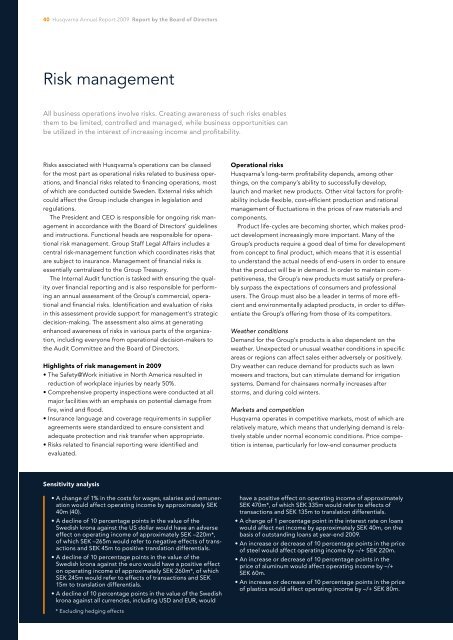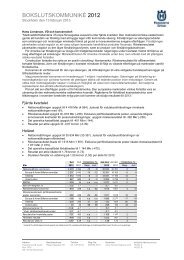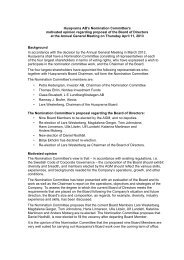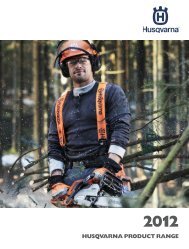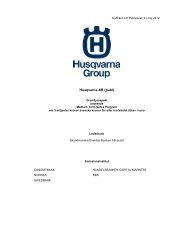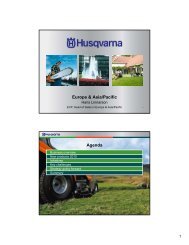Annual Report 2009 - Husqvarna Group
Annual Report 2009 - Husqvarna Group
Annual Report 2009 - Husqvarna Group
Create successful ePaper yourself
Turn your PDF publications into a flip-book with our unique Google optimized e-Paper software.
40 <strong>Husqvarna</strong> <strong>Annual</strong> <strong>Report</strong> <strong>2009</strong> <strong>Report</strong> by the Board of Directors<br />
Risk management<br />
All business operations involve risks. Creating awareness of such risks enables<br />
them to be limited, controlled and managed, while business opportunities can<br />
be utilized in the interest of increasing income and profitability.<br />
Risks associated with <strong>Husqvarna</strong>’s operations can be classed<br />
for the most part as operational risks related to business operations,<br />
and financial risks related to financing operations, most<br />
of which are conducted outside Sweden. External risks which<br />
could affect the <strong>Group</strong> include changes in legislation and<br />
regulations.<br />
The President and CEO is responsible for ongoing risk management<br />
in accordance with the Board of Directors’ guidelines<br />
and instructions. Functional heads are responsible for operational<br />
risk management. <strong>Group</strong> Staff Legal Affairs includes a<br />
central risk-management function which coordinates risks that<br />
are subject to insurance. Management of financial risks is<br />
essentially centralized to the <strong>Group</strong> Treasury.<br />
The Internal Audit function is tasked with ensuring the quality<br />
over financial reporting and is also responsible for performing<br />
an annual assessment of the <strong>Group</strong>’s commercial, operational<br />
and financial risks. Identification and evaluation of risks<br />
in this assessment provide support for management’s strategic<br />
decision-making. The assessment also aims at generating<br />
enhanced awareness of risks in various parts of the organization,<br />
including everyone from operational decision-makers to<br />
the Audit Committee and the Board of Directors.<br />
Highlights of risk management in <strong>2009</strong><br />
• The Safety@Work initiative in North America resulted in<br />
reduction of workplace injuries by nearly 50%.<br />
• Comprehensive property inspections were conducted at all<br />
major facilities with an emphasis on potential damage from<br />
fire, wind and flood.<br />
• Insurance language and coverage requirements in supplier<br />
agreements were standardized to ensure consistent and<br />
adequate protection and risk transfer when appropriate.<br />
• Risks related to financial reporting were identified and<br />
evaluated.<br />
Operational risks<br />
<strong>Husqvarna</strong>’s long-term profitability depends, among other<br />
things, on the company’s ability to successfully develop,<br />
launch and market new products. Other vital factors for profitability<br />
include flexible, cost-efficient production and rational<br />
management of fluctuations in the prices of raw materials and<br />
components.<br />
Product life-cycles are becoming shorter, which makes product<br />
development increasingly more important. Many of the<br />
<strong>Group</strong>’s products require a good deal of time for development<br />
from concept to final product, which means that it is essential<br />
to understand the actual needs of end-users in order to ensure<br />
that the product will be in demand. In order to maintain competitiveness,<br />
the <strong>Group</strong>’s new products must satisfy or preferably<br />
surpass the expectations of consumers and professional<br />
users. The <strong>Group</strong> must also be a leader in terms of more efficient<br />
and environmentally adapted products, in order to differentiate<br />
the <strong>Group</strong>’s offering from those of its competitors.<br />
Weather conditions<br />
Demand for the <strong>Group</strong>’s products is also dependent on the<br />
weather. Unexpected or unusual weather conditions in specific<br />
areas or regions can affect sales either adversely or positively.<br />
Dry weather can reduce demand for products such as lawn<br />
mowers and tractors, but can stimulate demand for irrigation<br />
systems. Demand for chainsaws normally increases after<br />
storms, and during cold winters.<br />
Markets and competition<br />
<strong>Husqvarna</strong> operates in competitive markets, most of which are<br />
relatively mature, which means that underlying demand is relatively<br />
stable under normal economic conditions. Price competition<br />
is intense, particularly for low-end consumer products<br />
Sensitivity analysis<br />
• A change of 1% in the costs for wages, salaries and remuneration<br />
would affect operating income by approximately SEK<br />
40m (40).<br />
• A decline of 10 percentage points in the value of the<br />
Swedish krona against the US dollar would have an adverse<br />
effect on operating income of approximately SEK –220m*,<br />
of which SEK –265m would refer to negative effects of transactions<br />
and SEK 45m to positive translation differentials.<br />
• A decline of 10 percentage points in the value of the<br />
Swedish krona against the euro would have a positive effect<br />
on operating income of approximately SEK 260m*, of which<br />
SEK 245m would refer to effects of transactions and SEK<br />
15m to translation differentials.<br />
• A decline of 10 percentage points in the value of the Swedish<br />
krona against all currencies, including USD and EUR, would<br />
have a positive effect on operating income of approximately<br />
SEK 470m*, of which SEK 335m would refer to effects of<br />
transactions and SEK 135m to translation differentials.<br />
• A change of 1 percentage point in the interest rate on loans<br />
would affect net income by approximately SEK 40m, on the<br />
basis of outstanding loans at year-end <strong>2009</strong>.<br />
• An increase or decrease of 10 percentage points in the price<br />
of steel would affect operating income by –/+ SEK 220m.<br />
• An increase or decrease of 10 percentage points in the<br />
price of aluminum would affect operating income by –/+<br />
SEK 60m.<br />
• An increase or decrease of 10 percentage points in the price<br />
of plastics would affect operating income by –/+ SEK 80m.<br />
* Excluding hedging effects


